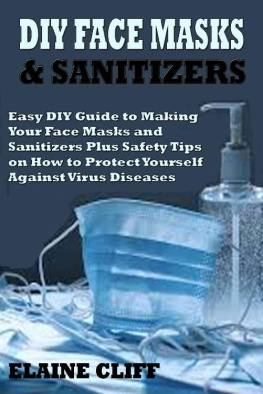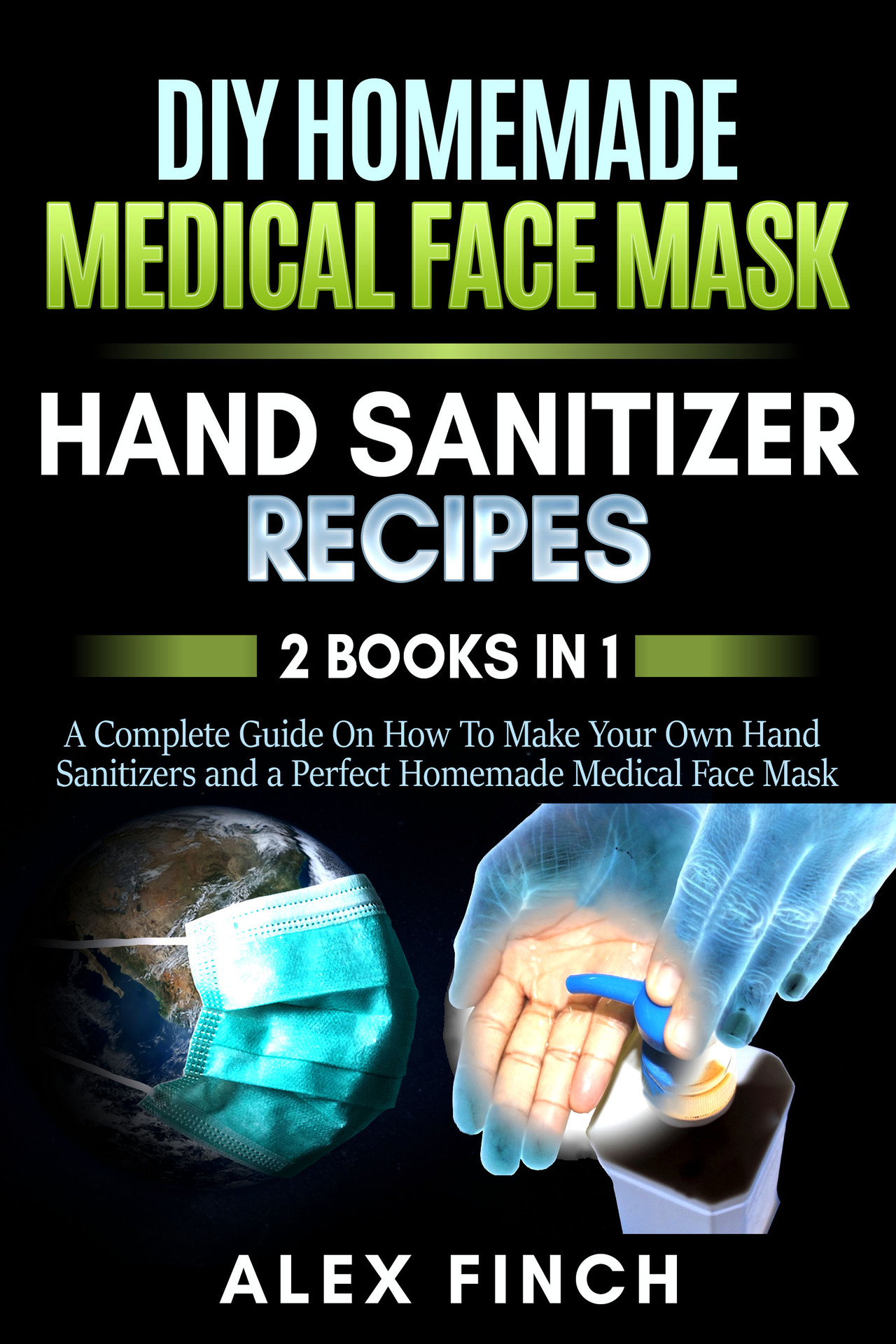DIY Homemade Medical Face Mask and a Perfect Hand Sanitizer
2 Books in 1:
A Complete Guide On How To Make Your Own Hand Sanitizers and a Perfect Homemade Medical Face Mask
BY
Alex Finch
Copyright 2020 Alex Finch
All rights reserved.
This document is geared towards providing exact and reliable information about the topic and issue covered. The publication is sold with the idea that the publisher is not required to render accounting, officially permitted or otherwise qualified services. If advice is necessary, legal or professional, a practiced individual in the profession should be ordered.
From a Declaration of Principles which was accepted and approved equally by a Committee of the American Bar Association and a Committee of Publishers and Associations.
In no way is it legal to reproduce, duplicate, or transmit any part of this document in either electronic means or printed format. Recording of this publication is strictly prohibited, and any storage of this document is not allowed unless with written permission from the publisher. All rights reserved.
The information provided herein is stated to be truthful and consistent, in that any liability, in terms of inattention or otherwise, by any usage or abuse of any policies, processes, or directions contained within is the sole and utter responsibility of the recipient reader. Under no circumstances will any legal obligation or blame be held against the publisher for any reparation, damages, or monetary loss due to the information herein, either directly or indirectly.
Respective authors own all copyrights not held by the publisher.
The information herein is offered for informational purposes solely and is universal as so. The presentation of the information is without a contract or any guarantee assurance.
The trademarks that are used are without any consent, and the publication of the logo is without permission or backing by the trademark owner. All trademarks and brands within this book are for clarifying purposes only and are owned by the owners themselves, not affiliated with this document
Table of Contents
DIY HOMEMADE MEDICAL FACE MASK
A Comprehensive Guide On How To Make Your Own Face Mask Easily At Home And Protect Yourself From Any Deadly
BY
Alex Finch
INTRODUCTION
A surgical mask, also referred to as the operating mask, a medical mask, or merely a face mask is used during surgery and nursing to remove bacteria from the mouth and nose of the person in fluid droplets and aerosols. They are not meant to shield the wearer from inhaling infectious bacterial or virus particles and are less effective than respirators, such as N95 or FFP masks, which, due to their design, form, and reliable seal, provide better security.
Surgical masks are commonly used by the general population in East Asian countries, including China, Japan, South Korea and Taiwan all year round, to reduce the risk of airborne pathogens transmitting and stopping airborne particulate matter from breathing. In addition, surgical masks have become a style comment, particularly in modern East Asian culture, backed by its prominence in Japanese and Korean pop culture, which has a significant influence on East Asian youth culture. More recent years, because of the growing issue of smog in South and Southeast Asia, air filters and surgical masks in significant towns in India, Nepal, and Thailand is now commonly used when air quality deteriorates to dangerous levels. Face masks are also used during the Southeast Asian haze season in Indonesia, Malaysia and Singapore. Surgical-style air-filtering masks are commonly used in Asia, which means that many businesses have launched masks not only block airborne pollutants from breathing in but are also trendy.
BRIEF HISTORY
It is hard to say exactly when face masks were used first to monitor operative sepsis. In 1897 Johann von Mikulicz Radecki 'identified a single layer of gauze mask. The same year, Fluegge's shows that ordinary conversations will spread nose and mouth droplets filled with bacteria, which reinforces the need for an efficient facemask. This marked the possibility of human exhalation as a cause of surgical sepsis. Huebner3 proposed in 1898 that during service masks consisting of two layers of gauze, worn away at a distance from the nose, be used. He demonstrated that the quality of masks had been increased by that gauze layers, and that masks had been worn close to the nose and minimized inefficiency. Hamilton4 proposed in 1905 the transmission of scarlet fever by droplet infection. She suggested that Mr. Spooner be worn with masks as an educational testing advisor for the 3 M company's Medical Products Division. He lectured widely in preparation procedures and aseptic techniques to nursing groups throughout the world. The nurses treat sterile dressings and doctors during surgery due to the possibility of mouth and nose gout infections. Lord Moynihan also called for the use of masks during operations in 1906. Over the next couple of years, multiple studies have verified the importance of face masks to shield the wearer from infection. In 1915 Meltzer6 recommended that fine mesh masks would be used to cover the mouths and hands of patients with child paralysis. In 1918 Reported that the incidence of double gauze masks employed by patients 'attendants was reduced to zero over two years. Interestingly, after each use, he suggested sterilizing the masks and replacing a sterile mask with a sterile one when it got moist and warned of the hands put on the mask. The same year Capps adopted the Weaver protocol and confirmed the efficacy of facial masks in military hospitals for the safety of staff attending patients with infectious diseases and for the safety of patients from cross-infection.
FACE MASK
A surgical mask or operating mask is meant to be used by emergency personnel during surgery and other emergency operations to remove microorganisms from their mouths and nose into liquid droplets and aerosols. The French physician Paul Berger used it for the first time in 1897 during an operation in Paris. Traditional operating masks are made of paper or other non-woven material and should be discarded after each use.
A surgical mask should not be confused with and approved to be a respirator. Surgical masks are not designed to shield the wearer from inhaling infectious bacteria or viral parts and are less effective than respirators for this purpose.
Face masks are one method used to deter disease transmission. Dental masks, safety, laser, medical, treatment and surgical masks can all be referred to. Face masks are loose-fitting masks, shielding the nose and lips, which have earrings or braces at the back of the ears. There are several different brands, and the colors are distinctive. It is necessary to use an FDA-approved facial mask.
Facemasks tend to reduce germ dissemination. If someone speaks, coughs or sneezes, little drops will come into the air and will allow someone to get sick. When anyone has facial masks, they can decrease the number of germs released by the wearer and prevent others from getting sick. A facial mask also prevents the nose and mouth of the wearer from splashing or body fluid sprays.
Health care workers
Easy surgical masks protect wearers against body fluid sprinklers in the mouth and prevent the transfer of body fluids from the wearer to others, e.g., the patient. This also warns users not to cover their mouth or nose, which, after a contaminated surface (fomite), may spread viruses and bacteria. These will also decrease the spread of contagious fluid gout (carrying bacteria or viruses) produced through cough or sneezing of the wearer. There is no convincing indication that interchangeable face masks used by members of the surgical team would reduce the risk of injury infections following clean surgery.










